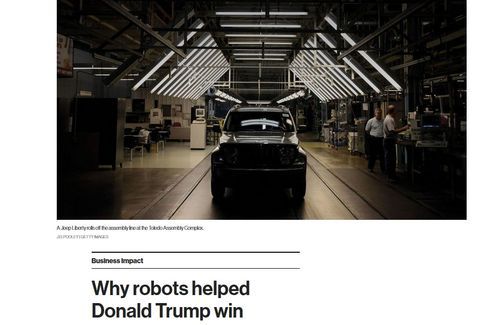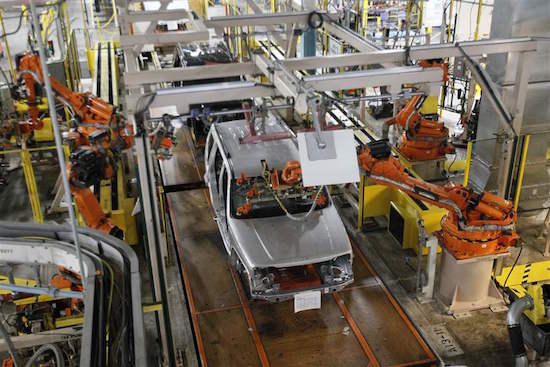


06/25/2018
During the last presidential campaign, I paid close attention to hear any mention from the candidates about automation as a cause of future job loss, but it never was forthcoming.
Now the MIT Technology publication proposes that automation in the rust belt was a critical factor in Trump’s election.
Below, robots install a Jeep window at the Toledo Assembly Plant.

MIT chose to investigate Toledo, Ohio, a city which has the nation’s highest concentration of robots in the work force, according to a 2017 report in the Toledo Blade.
So the situation there is a peek into the near-future of the roboticized workplace. Reactions among workers are complicated: they appreciate less damage to their bodies, but can see more machines are coming to replace them:
When [Rickey] and his buddy, who sat next to him drinking a post-shift beer, started at the plant, they had about 1,600 fellow workers, they said. Now there are about 600.
Middle East Motoring reported about a visit to a Toledo factory including a video showing 18 Robots working together on Jeep Cherokee at Toledo plant:
Apparently there is a recent unnamed study from Oxford University that concluded, “Michigan, Wisconsin, and Pennsylvania would have swung in favor of Hillary Clinton if robot adoption had been 2 percent lower over the investigated period, leaving the Democrats with a majority in the Electoral College.” It would be nice to have the details, but they are not available. Certainly Donald Trump’s emphasis on a better deal for American workers was taken to heart by Midwestern voters on election day.
The biggest value of the article may be the snapshot of the automation economy being created with its manufacturing efficiency and worries for workers.
Why robots helped Donald Trump win, MIT Technology Review, June 21, 2018
Toledo has more robots per worker than any other US city. They’re producing a healthy economy — and lots of anxiety.
Ronald Shrewsbery II used to be the Robot Doctor. Now he’s known by the more bureaucratic-sounding title “WCM (World Class Manufacturing) Electrical Technical Specialist,” but he still doctors the robots. There are a thousand of these machines inside Ohio’s Toledo Assembly Complex, a 312-acre manufacturing leviathan dedicated to producing Jeeps. Huddles of one-armed robots hover over metal pieces, putting the parts together on their own. In the paint shop, robots spray coats of paint on Wrangler bodies.
The Toledo Assembly Complex is one of the most heavily automated car factories in the United States. It can extrude 500 cars in a shift, far more than the Cove, the old Jeep plant that was shut down in 2006. And the machines make the work easier. There used to be a lot more lifting, more pushing. Painters wore head-covering masks with air hoses, like old-time deep-sea divers. Welders in the body shop wrestled hanging guns. So you’d get people “with [bad] backs, arms, carpal tunnel, rotator cuffs,” Shrewsbery says. “It tore you up physically.” The new factory is as clean as an operating room in some spots, nothing like the darker, dirtier Cove. The cars rolling off the line are better, too.
Shrewsbery himself started in 1984 as a grunt-level assembly-line worker at the Cove. Then he bid on an opening to learn the electrician’s trade, and mastered it. His story is the fulfillment of a techno-optimist’s dream: automation gave him a chance to learn a new skill and earn a much better wage, just as it made the plant he works in more efficient, safer, and cleaner.
But even though the economy in Toledo is better than it has been in years, thanks in no small part to decisions by local authorities and industries to aggressively embrace new technologies, the changes are also creating an uncertain and worrisome future for many people. And they are expressing their worries at the ballot box.
Donald Trump’s campaign slogan “Make America great again” resonated with many in this part of the country. The heavily industrialized counties along Ohio’s western Lake Erie shore voted for Barack Obama twice. In 2016, most voted for Trump, flipping the state from the Democratic candidate to the Republican. Lucas County, where Toledo sits, did pick Hillary Clinton, but by much less than the 2:1 margins Obama had enjoyed.
Michigan, Wisconsin, and Pennsylvania would have swung to Clinton if robot adoption had been 2 percent lower.
In a recent paper, Oxford University researchers concluded that “Michigan, Wisconsin, and Pennsylvania would have swung in favor of Hillary Clinton if robot adoption had been 2 percent lower over the investigated period, leaving the Democrats with a majority in the Electoral College.” According to a 2017 study by the Brookings Institution, the Toledo metropolitan area is the most roboticized in the United States, with nine robots per 1,000 workers. There were 702 robots there in 2010. By 2015, there were 2,374. There are more now. In March, another study estimated that the state had lost 671,000 jobs to automation between 1967 and 2014, more than it lost to domestic competition (such as from right-to-work states, which restrict the power of unions) and foreign trade combined.